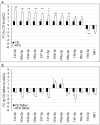Sperm microRNA Content Is Altered in a Mouse Model of Male Obesity, but the Same Suite of microRNAs Are Not Altered in Offspring's Sperm
- PMID: 27814400
- PMCID: PMC5096664
- DOI: 10.1371/journal.pone.0166076
Sperm microRNA Content Is Altered in a Mouse Model of Male Obesity, but the Same Suite of microRNAs Are Not Altered in Offspring's Sperm
Abstract
The prevalence of obesity is increasing worldwide and has tripled in men of reproductive age since the 1970s. Concerningly, obesity is not only comorbid with other chronic diseases, but there is mounting evidence that it increases the non-communicable disease load in their children (eg mortality, obesity, autism). Animal studies have demonstrated that paternal obesity increases the risk of metabolic (eg glucose metabolism defects, obesity) and reproductive disorders in offspring. Epigenetic changes within sperm are clear mechanistic candidates that are associated with both changes to the father's environment and offspring phenotype. Specifically there is emerging evidence that a father's sperm microRNA content both responds to paternal environmental cues and alters the gene expression profile and subsequent development of the early embryo. We used a mouse model of high fat diet (HFD) induced obesity to investigate whether male obesity could modulate sperm microRNA content. We also investigated whether this alteration to a father's sperm microRNA content lead to a similar change in the sperm of male offspring. Our investigations were initially guided by a Taqman PCR array, which indicated the differential abundance of 28 sperm borne microRNAs in HFD mice. qPCR confirmation in a much larger cohort of founder males demonstrated that 13 of these microRNAs were differentially abundant (11 up-regulated; 2 down-regulated) due to HFD feeding. Despite metabolic and reproductive phenotypes also being observed in grand-offspring fathered via the male offspring lineage, there was no evidence that any of the 13 microRNAs were also dysregulated in male offspring sperm. This was presumably due to the variation seen within both groups of offspring and suggests other mechanisms might act between offspring and grand-offspring. Thus 13 sperm borne microRNAs are modulated by a father's HFD and the presumed transfer of this altered microRNA payload to the embryo at fertilisation potentially acts to alter the embryonic molecular makeup post-fertilisation, altering its growth trajectory, ultimately affecting adult offspring phenotype and may contribute to paternal programming.
Conflict of interest statement
The authors have declared that no competing interests exist.
Figures

Similar articles
-
Paternal obesity initiates metabolic disturbances in two generations of mice with incomplete penetrance to the F2 generation and alters the transcriptional profile of testis and sperm microRNA content.FASEB J. 2013 Oct;27(10):4226-43. doi: 10.1096/fj.12-224048. Epub 2013 Jul 11. FASEB J. 2013. PMID: 23845863
-
Preconception diet or exercise intervention in obese fathers normalizes sperm microRNA profile and metabolic syndrome in female offspring.Am J Physiol Endocrinol Metab. 2015 May 1;308(9):E805-21. doi: 10.1152/ajpendo.00013.2015. Epub 2015 Feb 17. Am J Physiol Endocrinol Metab. 2015. PMID: 25690453
-
Obese father's metabolic state, adiposity, and reproductive capacity indicate son's reproductive health.Fertil Steril. 2014 Mar;101(3):865-73. doi: 10.1016/j.fertnstert.2013.12.007. Epub 2014 Jan 11. Fertil Steril. 2014. PMID: 24424359
-
Paternal obesity, interventions, and mechanistic pathways to impaired health in offspring.Ann Nutr Metab. 2014;64(3-4):231-8. doi: 10.1159/000365026. Epub 2014 Oct 2. Ann Nutr Metab. 2014. PMID: 25300265 Review.
-
Age-associated epigenetic changes in mammalian sperm: implications for offspring health and development.Hum Reprod Update. 2023 Jan 5;29(1):24-44. doi: 10.1093/humupd/dmac033. Hum Reprod Update. 2023. PMID: 36066418 Free PMC article. Review.
Cited by
-
Consequences of Paternal Nutrition on Offspring Health and Disease.Nutrients. 2021 Aug 17;13(8):2818. doi: 10.3390/nu13082818. Nutrients. 2021. PMID: 34444978 Free PMC article. Review.
-
MicroRNA Signaling in Embryo Development.Biology (Basel). 2017 Sep 14;6(3):34. doi: 10.3390/biology6030034. Biology (Basel). 2017. PMID: 28906477 Free PMC article. Review.
-
The Heritability of Behaviors Associated With the Host Gut Microbiota.Front Immunol. 2021 May 13;12:658551. doi: 10.3389/fimmu.2021.658551. eCollection 2021. Front Immunol. 2021. PMID: 34054822 Free PMC article. Review.
-
Maternal Western-style diet reduces social engagement and increases idiosyncratic behavior in Japanese macaque offspring.Brain Behav Immun. 2022 Oct;105:109-121. doi: 10.1016/j.bbi.2022.07.004. Epub 2022 Jul 6. Brain Behav Immun. 2022. PMID: 35809877 Free PMC article.
-
Dysfunction of DMT1 and miR-135b in the gut-testis axis in high-fat diet male mice.Genes Nutr. 2024 Jan 19;19(1):1. doi: 10.1186/s12263-024-00737-6. Genes Nutr. 2024. PMID: 38243197 Free PMC article.
References
-
- Ng M, Fleming T, Robinson M, Thomson B, Graetz N, Margono C, et al. Global, regional, and national prevalence of overweight and obesity in children and adults during 1980–2013: a systematic analysis for the Global Burden of Disease Study 2013. Lancet. 2014; 384: 766–781. 10.1016/S0140-6736(14)60460-8 - DOI - PMC - PubMed
MeSH terms
Substances
LinkOut - more resources
Full Text Sources
Other Literature Sources
Medical

